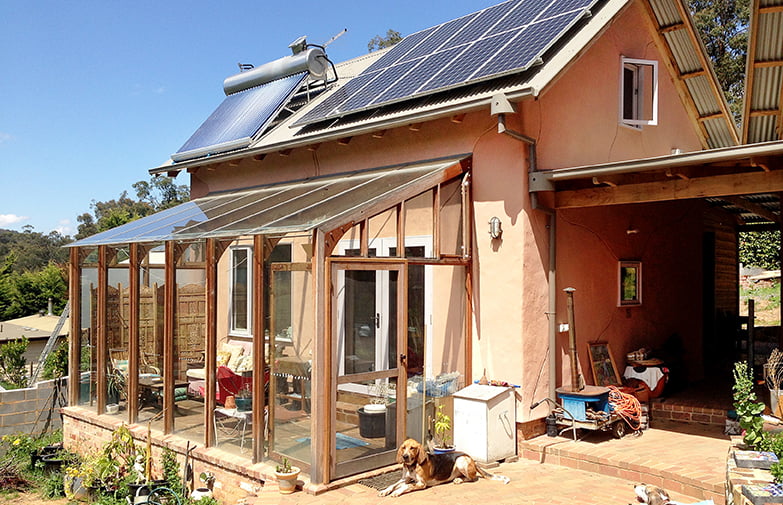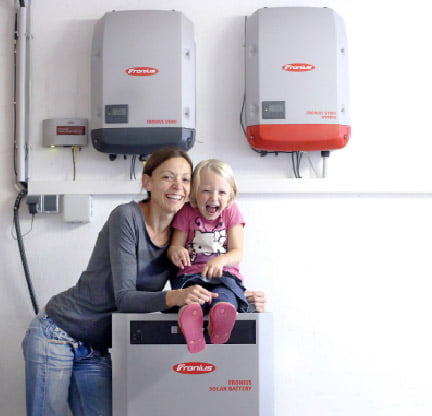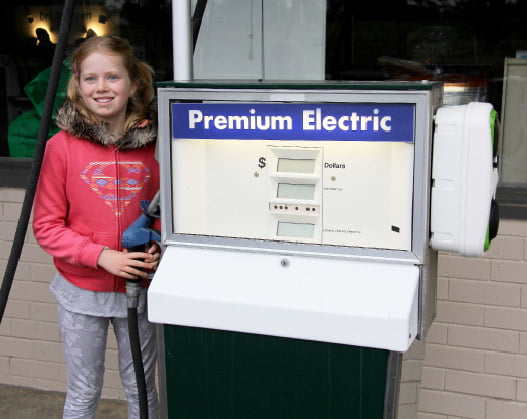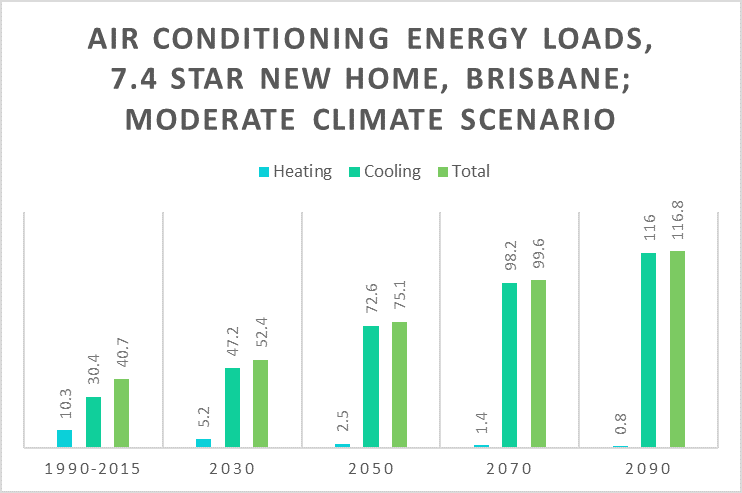Should you quit the grid?

Debate abounds on whether going off-grid is the ‘greenest’ response for those households wanting to reduce their environmental impact and reduce energy bills. Andrew Reddaway steps through the multiple ways households are connected to the grid, and explains what’s involved with cutting ties.
Going off-grid certainly has its attractions – self-sufficiency and no more bills! While many of us think mostly of electricity when planning on quitting the grid there are in fact three energy ‘grids’ most Australian households rely on in their day to day lives, including the electricity grid, gas network (piped gas and bottled gas), and petrol stations.
Disconnecting your home from all three grids is possible, but it’s challenging and may require a large up-front investment. Quitting one or two is a lot easier and can still provide quite a high level of self-sufficiency.
Off-grid versus grid-connected solar systems
More than 16 per cent of Aussie homes have solar electricity. Recently installed solar systems tend to be quite large, around 4 kilowatts (kW) or 16 panels. Such a system’s annual generation exceeds many households’ annual electricity consumption. Can’t these people simply mount a battery on the garage wall and sever their electricity connection? One hurdle is that normal grid-connected solar systems are quite simple – they rely on connection to a big, stable electricity grid. Without the grid, they can’t cope with the fluctuations of appliances turning on and off. A bigger problem is that they can’t generate enough electricity on a cloudy day.
Adding a small battery to a grid-connected solar system has some benefits (discussed later), but it won’t generally enable you to go off-grid. This kind of system retains a grid connection, and is referred to as a ‘hybrid’ solar system.
Sizing an off-grid solar system
The real challenge is getting through a cloudy week. Let’s consider a family in Sydney with a moderately low electricity consumption of 10 kilowatt-hours (kWh) per day (you can find your daily energy consumption or ‘usage’ on your bill). We’ll assume they’re installing an off-grid solar system using industry-standard lead-acid batteries. As a rough indication, they would need 10kW of solar (30–40 panels) and batteries with a rated energy storage capacity of 65kWh, weighing nearly two tonnes. After adding robust, smart components required to deal with fluctuations, the total installed cost would be around $55,000. A smaller or cheaper system could be installed instead, but this would probably involve some compromises such as a shorter lifespan, lower level of reliability, lower electricity consumption during cloudy weeks, and/or greater use of a generator.
The required system size varies with how much sunlight your location receives, and how much electricity you consume per day.
Generators
An off-grid solar system like that described earlier can cope with a moderately cloudy week, but not an exceptionally dark one such as during the east coast flooding in June 2016. Many solar owners reported that their panels generated negligible electricity at this time. People living off-grid normally rely on a petrol or diesel generator to deal with such events, as well as during periods when guests are visiting and using extra electricity, or when sunlight is blocked by bushfire smoke, for example.
Diesel generators are preferred over petrol for reliability, safety and fuel economy. A good off-grid solar system can start up the generator when required (as long as it has an auto-start feature). Larger generators don’t have to run for so long, and fumes and noise need to be accommodated. A generator with all these features might cost around $7000. Generators are by far the most expensive way to produce electricity, so runtime should be minimised.
Lifestyle
An off-grid solar system like the one discussed delivers electricity equivalent in quality to the grid, enabling residents to use standard appliances. Maintenance requirements are minimal. ‘Off-gridders’ might check their battery level by reading a display located at a convenient spot. The generator needs to be refilled with fuel from a container occasionally. Some battery types need to be inspected about once per month and topped up with water if necessary. Probably the biggest change in lifestyle is developing an awareness of the season and the weather, and understanding when it’s wise to occasionally cut back on electricity use. When the sun’s out and the battery’s full, you have electricity in abundance!
With a hybrid system there is no impact on lifestyle, because any shortfall from the solar is automatically covered by the grid.
Where can I put the batteries?
There are many different types of battery available, but few of them are suitable for placement inside your home. Most batteries’ lifespan will be improved by a stable, cool temperature, so try not to locate them in direct summer sun or an uninsulated, unshaded metal shed. In the unlikely event of a fault, some batteries can catch fire, and others can release flammable hydrogen gas so they need proper ventilation. For more details, please refer to manufacturers’ recommendations and the Clean Energy Council battery installation guide. Many off-grid households use a shed to house the solar system, generator, water pump, et cetera, with buried cables and pipes leading to the house.
Due to these potential risks for batteries, you should check if adding a battery will affect your insurance.

Environmental considerations of off-grid electricity
If you have a grid connection available, an off-grid solar system is generally not an especially ‘green’ option. On a sunny day your batteries will charge up quickly, so a lot of your panels’ generation will be excess to requirements and wasted. If you had a grid connection, this excess generation would have been fed into the grid, reducing the amount of electricity generated by coal and gas power stations. For more info, please see the article “How green is my solar” in ReNew 135.
Battery replacement and consumer protections
After quitting the electricity grid you’ll no longer worry about ‘bill shock’, and you avoid connection charges on your electricity and gas bills that you would normally pay while connected to a network, regardless of how much energy you use. However it might be wise to start planning for a different expense: a new battery. Depending on how hard it’s been worked and its operating temperature, you’d generally expect an off-grid battery to last about 10 years. Battery prices are expected to fall, but replacement will still amount to a significant fraction of the original system cost. Panels should last 25 years or more, but some other electronic components, such as the inverter, may also need replacing after around 10 years.
When you have a grid connection, electricity is treated as an essential service. If you have difficulty paying your bill, your retailer is required to allow for hardship situations and in the case of a dispute, you can appeal to an electricity ombudsman. But with an off-grid electricity system your only protection is via standard consumer law for example; goods must be of ‘acceptable quality’ and match any description provided.
Renting or selling your home
Off-grid electricity systems are unusual. If you wanted to rent or sell your home, electricity supply could be a concern to potential tenants or buyers. On the other hand some people would value the home’s self-sufficiency.
If new residents (or you) want to re-connect to the grid, you may first have to get a certificate stating that your house wiring meets current specifications. Older houses may need their wiring upgraded, which is an expensive exercise and reconnecting may incur upfront connection cost.
Blackout protection
If your main concern is to retain power during a grid blackout, you don’t need an off-grid solar system. A hybrid solar system has a grid connection and also batteries. Most city-dwellers are much more likely to install one of these than go off-grid. If you take this option, check that the system really can work when the grid is down. Rather than powering the whole house, you could separate your switchboard so that non-essential appliances will run only when the grid is up.
The other main benefit of a hybrid solar system (compared to solar without batteries) is additional bill savings. However, given the upfront cost, these savings are currently unattractive. For more info on bill savings, refer to the article “Solar plus batteries – when will they add up?” in ReNew 134.
A relatively cheap option is to use smaller devices during a blackout, such as camping lights and stove, an Uninterruptible Power Supply (UPS) for computer equipment and a small generator and extension lead for the fridge. It’s also possible to install a small off-grid solar system to run some of your appliances, for example a fridge and some lights.
Quitting the gas grid
Compared to electricity, disconnecting from the gas network is easy and cheap! Gas is typically used for heating the house, hot water and cooking. For each of these functions, high-efficiency electric appliances are now available that are often cheaper to run than gas versions, including reverse-cycle air conditioners, heat pump hot water or solar hot water and induction cooktops. You can replace your gas appliances with electric ones on your own schedule, for example as they wear out or during a renovation. In addition to the energy cost, you would also save gas connection charges which typically amount to a few hundred dollars per year.
Outside the tropics, space heating and hot water consume a lot of energy. If you’re quitting the electricity grid, using electricity for these functions would place heavy demands on your solar system, especially during a cold, cloudy winter week. Using gas or firewood for heating would trim your up-front costs and/or generator runtime.
Quitting the petrol grid
To disconnect from the petrol station network you need to switch to other transport options. Electric vehicles (EVs) are still rare in Australia, but will become popular if battery prices drop as expected, or if petrol prices rise again. An average Aussie car is driven about 40km per day, which would require around 8kWh of electricity to recharge. If the family mentioned above got an EV and charged it at home, their electricity consumption might double! However their overall energy consumption would decrease, because electric motors are much more efficient than internal combustion engines. An EV’s efficiency makes it a reasonably ‘green’ choice, even when charged from our dirty electricity grid. And it’s likely to become greener over its lifespan, as more renewable energy generation is installed.
If you quit the electricity grid, on sunny days you would have plenty of spare electricity from your off-grid system to top up an EV. Your challenge would again be a cloudy week, or if you arrive home after sunset with an empty car battery and need to make a long drive in the morning. Perhaps you could use public charging stations at times like these?
Of course, if you can do without a car, there are many cheaper and greener transport options that also don’t depend on petrol stations, such as some public transport, electric bikes (which have tiny batteries compared to electric cars) and even walking.

Energy efficiency
Investments to reduce energy consumption normally achieve quick payback. If you’re quitting the electricity grid, they’ll pay off even quicker! Each dollar spent on reducing electricity usage may shave several dollars from your off-grid solar system’s price tag. Consider LED lights, insulation, draught sealing, window shading, efficient appliances, et cetera.
Building or renovation projects present great opportunities to prepare to go off-grid, such as building orientation, eaves, placement and quality of windows and doors, and insulation.
From an environmental point of view, your electricity from the grid can effectively be ‘greened’ by installing solar panels that generate more electricity over the year than you consume. Alternatively you could switch to a GreenPower plan – its higher price offsets your electricity’s environmental impact by funding new renewable energy projects. Another simple option is to purchase carbon offsets, for example the ATA’s C3 offering.
Developing a plan of action
So, is it a good idea to sever your home’s connection to all three energy grids? Everyone’s situation and priorities are different, but this is unlikely to be a cost-effective or green option for most people.
For the household seeking a balance of environmental impact, self-sufficiency and cost, a good strategy might be:
1. Reduce electricity consumption where possible.
2. Remain on the electricity grid, but guard against blackouts with emergency equipment and/or a hybrid solar system; and clean up your electricity source with solar panels or GreenPower.
3. Quit the gas network gradually by replacing gas appliances with efficient electric ones as they wear out.
4. If possible, quit the petrol station network by switching to other transport options.
This path leads to a household connected to only one energy network instead of three, paying small bills, resilient to blackouts and with a small or positive environmental energy footprint.
Further resources
Article in ReNew 135: How green is my solar?
ATA report: Are we still cooking with gas?
Article in ReNew 134: Solar plus batteries – when will they add up?
ATA’s Community Climate Chest – C3 carbon offsets
ATA energy and solar advice service
More on solar + batteries
 Advocacy
Advocacy
Australia must achieve zero emissions homes by 2035
Renew's submission to the Climate Change Authority argues that decarbonising homes is a critical opportunity.
Read more Advocacy
Advocacy
Future-proofing Australia’s homes
Energy needed to cool homes is set to soar. A new report shows out of date climate data used for energy efficiency ratings will keep us sweating.
Read more


